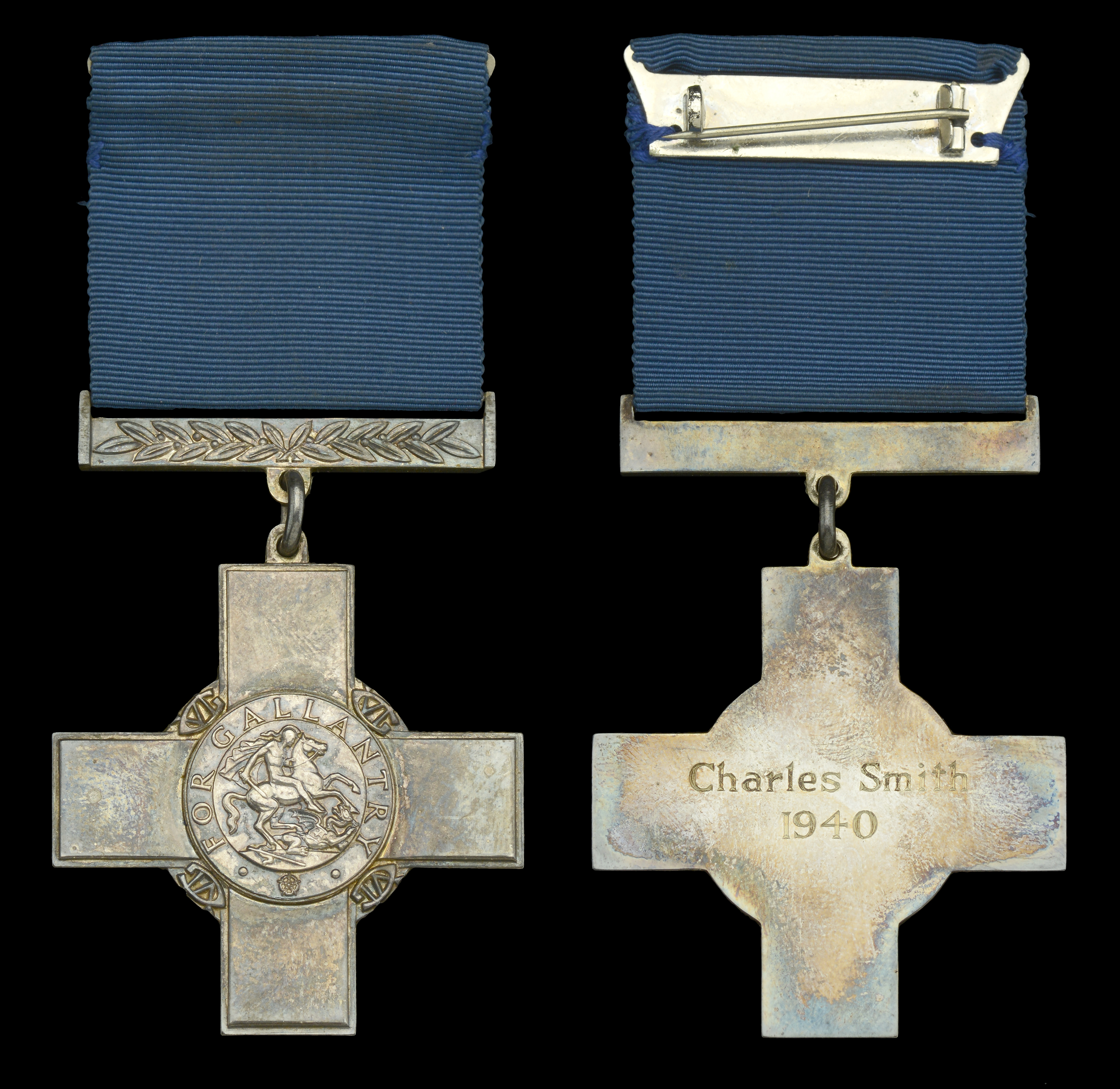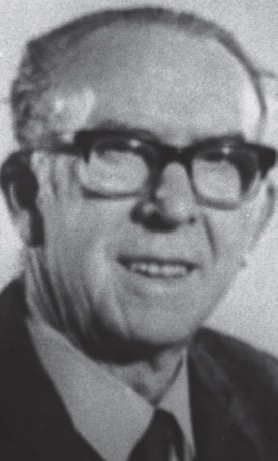14
A George Cross (exchange Edward Medal) awarded to mineworker Mr. C. Smith, for his...
Gebote sind ohne Steuern, Aufgeld oder Versankosten.
By confirming your bid, you agree that you have read and accepted the-saleroom.com and the auctioneer's terms and conditions. Confirming your bid is a legally binding obligation to purchase and pay for the lot should your bid be successful.
Wählen Sie eine der folgenden Schnellgebotsoptionen:
Gebote sind ohne Steuern, Aufgeld oder Versankosten.
By confirming your bid, you agree that you have read and accepted the-saleroom.com and the auctioneer's terms and conditions. Confirming your bid is a legally binding obligation to purchase and pay for the lot should your bid be successful.
George Cross (Charles Smith 1940) in Royal Mint case of issue, extremely fine £8,000-£10,000
---
E.M. London Gazette 28 June 1940 (in a joint citation with Gwyn Morgan [awarded the Edward Medal in Silver] and Matthew Thompson [awarded the Edward Medal]):
‘At 10 a.m. on the 3rd January, 1940, a fall of roof occurred at a coal face in Warren House Seam at Askern Main Colliery, Yorkshire, and a miner named Charles Liversidge was buried by the fall. He was extricated some three hours later, without having suffered serious injury, through the gallantry displayed, in conditions of the greatest risk, by a rescue party.
Morgan, the Agent of the Colliery, arrived a few minutes after the accident and took charge of the operations. With great difficulty a way was cleared under the fall, and it was found that Liversidge was completely buried, except for his head and shoulders, and that his arms were pinned by fallen rocks and by a steel bar. Morgan succeeded in removing a stone which was pinning one of his arms. Later, when one of the other men had failed, he succeeded in getting through to Liversidge and after thirty minutes' work in the most cramped position was able to free him and to pass him through to the other rescuers. Throughout he displayed outstanding courage, resource, and leadership.
Smith and Thompson were both close at hand when the fall occurred and at once commenced rescue operations. They took a prominent part in the dangerous work of clearing a way under the fall, and both were able to remove some of the debris which had pinned Liversidge down. Thompson attempted to get through to effect the final release of Liversidge, but was driven back by a further fall.
The whole work of rescue was carried on in the most difficult and dangerous conditions, and slight falls occurred frequently. A further heavy fall occurred later in the day which completely closed the passage through which the rescue had been made.’
Charles Smith was born at Ince, Wigan, Lancashire, on 17 December 1908 and was educated at St. William’s Roman Catholic School, Ince, before following in his father’s footsteps as a miner from the age of 12. Employed as a miner at Askern Main Colliery, near Doncaster, Yorkshire, he was awarded the Edward Medal for his gallantry in saving the life of a trapped miner, buried by a roof fall in the Warren House Seam. For this act of gallantry he also received a Carnegie Hero Trust Fund Certificate on 25 April 1940. He was invested with his Edward Medal, alongside Gwyn Morgan and Matthew Thompson, by H.M. King George VI at Buckingham Palace on 2 July 1940.
Following his Edward Medal exploits, Smith attested for the Royal Artillery, and served with 60 Regiment during the Second World War in Burma, being advanced to the rank of Sergeant. For his wartime services he was awarded the 1939-45 Star; the Burma Star; the Defence Medal; and the War Medal 1939-45. Following demobilisation in 1945, he returned to his coal industry, and was employed on the surface as a banksman at Stargate Colliery, Ryton-on-Tyne, County Durham, from 1945 to 1961.
On 3 February 1953, whilst at work at the Stargate Colliery, Smith spotted a fracture in one of the main cables on the mine shaft lift, just as the lift, full of miners, was about to be lowered down the shaft; pointing this out to the foreman, the lift was emptied and the cable replaced. In a letter to the recipient from the Colliery’s Consultative Committee, dated 19 February 1953, the Secretary of the Committee thanked him ‘for the manner in which you averted a disastrous occurrence ... we all realise just how close a call it was and all sections unite in appreciating your presence of mind and quick reaction to signs of danger.’
Awarded a gratuity of £10 by the Durham Division of the National Coal Board, as a token of appreciation, Smith subsequently worked in the coking industry at Derwenthaugh, County Durham, from 1961 until his retirement in 1973. Having elected to exchange his Edward Medal for the George Cross, he was invested with his G.C. by H.M. Queen Elizabeth II at Buckingham Palace on 18 July 1972, and subsequently received the Silver Jubilee Medal in 1977. He died at Blaydon, County Durham, on 25 October 1987.
Sold with a copy of the original citation for the Edward Medal, housed in a glazed frame; two original letters to the recipient, one for the Stargate Colliery Consultative Committee, the other from the National Coal Board (Durham Division), regarding the recipient’s act in spotting the fractured lift cage cable, both dated February 1953; and two newspaper cuttings regarding the recipient’s G.C. investiture.
George Cross (Charles Smith 1940) in Royal Mint case of issue, extremely fine £8,000-£10,000
---
E.M. London Gazette 28 June 1940 (in a joint citation with Gwyn Morgan [awarded the Edward Medal in Silver] and Matthew Thompson [awarded the Edward Medal]):
‘At 10 a.m. on the 3rd January, 1940, a fall of roof occurred at a coal face in Warren House Seam at Askern Main Colliery, Yorkshire, and a miner named Charles Liversidge was buried by the fall. He was extricated some three hours later, without having suffered serious injury, through the gallantry displayed, in conditions of the greatest risk, by a rescue party.
Morgan, the Agent of the Colliery, arrived a few minutes after the accident and took charge of the operations. With great difficulty a way was cleared under the fall, and it was found that Liversidge was completely buried, except for his head and shoulders, and that his arms were pinned by fallen rocks and by a steel bar. Morgan succeeded in removing a stone which was pinning one of his arms. Later, when one of the other men had failed, he succeeded in getting through to Liversidge and after thirty minutes' work in the most cramped position was able to free him and to pass him through to the other rescuers. Throughout he displayed outstanding courage, resource, and leadership.
Smith and Thompson were both close at hand when the fall occurred and at once commenced rescue operations. They took a prominent part in the dangerous work of clearing a way under the fall, and both were able to remove some of the debris which had pinned Liversidge down. Thompson attempted to get through to effect the final release of Liversidge, but was driven back by a further fall.
The whole work of rescue was carried on in the most difficult and dangerous conditions, and slight falls occurred frequently. A further heavy fall occurred later in the day which completely closed the passage through which the rescue had been made.’
Charles Smith was born at Ince, Wigan, Lancashire, on 17 December 1908 and was educated at St. William’s Roman Catholic School, Ince, before following in his father’s footsteps as a miner from the age of 12. Employed as a miner at Askern Main Colliery, near Doncaster, Yorkshire, he was awarded the Edward Medal for his gallantry in saving the life of a trapped miner, buried by a roof fall in the Warren House Seam. For this act of gallantry he also received a Carnegie Hero Trust Fund Certificate on 25 April 1940. He was invested with his Edward Medal, alongside Gwyn Morgan and Matthew Thompson, by H.M. King George VI at Buckingham Palace on 2 July 1940.
Following his Edward Medal exploits, Smith attested for the Royal Artillery, and served with 60 Regiment during the Second World War in Burma, being advanced to the rank of Sergeant. For his wartime services he was awarded the 1939-45 Star; the Burma Star; the Defence Medal; and the War Medal 1939-45. Following demobilisation in 1945, he returned to his coal industry, and was employed on the surface as a banksman at Stargate Colliery, Ryton-on-Tyne, County Durham, from 1945 to 1961.
On 3 February 1953, whilst at work at the Stargate Colliery, Smith spotted a fracture in one of the main cables on the mine shaft lift, just as the lift, full of miners, was about to be lowered down the shaft; pointing this out to the foreman, the lift was emptied and the cable replaced. In a letter to the recipient from the Colliery’s Consultative Committee, dated 19 February 1953, the Secretary of the Committee thanked him ‘for the manner in which you averted a disastrous occurrence ... we all realise just how close a call it was and all sections unite in appreciating your presence of mind and quick reaction to signs of danger.’
Awarded a gratuity of £10 by the Durham Division of the National Coal Board, as a token of appreciation, Smith subsequently worked in the coking industry at Derwenthaugh, County Durham, from 1961 until his retirement in 1973. Having elected to exchange his Edward Medal for the George Cross, he was invested with his G.C. by H.M. Queen Elizabeth II at Buckingham Palace on 18 July 1972, and subsequently received the Silver Jubilee Medal in 1977. He died at Blaydon, County Durham, on 25 October 1987.
Sold with a copy of the original citation for the Edward Medal, housed in a glazed frame; two original letters to the recipient, one for the Stargate Colliery Consultative Committee, the other from the National Coal Board (Durham Division), regarding the recipient’s act in spotting the fractured lift cage cable, both dated February 1953; and two newspaper cuttings regarding the recipient’s G.C. investiture.
Orders, Decorations, Medals and Militaria
Auktionsdatum
Ort der Versteigerung
Generelle Versandinformationen vom Auktionshaus verfügbar
If you are successful in purchasing lot/s being auctioned by us and opt for the item/s to be sent to you, we will use the following methods of shipment:
Within the UK
If you live within the UK, items will be despatched using Royal Mail Special Delivery. This service provides parcel tracking (via the Royal Mail website) and next weekday delivery (betwen 9am and 1pm). Items delivered within the UK are covered by our insurance company. Heavy and bulky lots will be sent by courier, in discussion with the client.
Outside of the UK
If the item/s being sent are worth under £1000 in total they are sent using Royal Mail’s Signed For International service. This ensures the item must be signed for when it is delivered.
If the item/s being sent are valued at over £1000 in total they will be sent using FedEx. This service allows next day delivery to customers in many parts of the US and parcels are fully trackable using the FedEx website.
Shipping Exceptions
Certain lots such as those containing glass or sharp implements, etc., may not be suitable for in-house shipping within or outside of the UK. Please contact Noonans with any queries.
Wichtige Informationen
Auctioneer's Buyers Premium: 24% (+VAT)
There is an additional charge of 4.95% (+VAT/sales tax)














